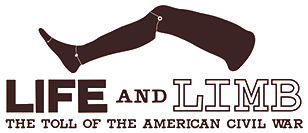
Class 2: Battlefields and Bullets: The Red Badge of Courage
Introduction:
This second class develops some of the themes introduced in Class 1 with a focus on the personal and proximate experience of battle and physical injury in the Civil War via extracts from three contrasting narrative responses: Louisa May Alcott’s Hospital Sketches (1863), Gone for a Soldier: The Civil War Memoirs of Private Alfred Bellard (1991), and Stephen Crane’s famous fictional Civil War novel, The Red Badge of Courage (1895). These are supplemented by four secondary-source readings that explain and explore the military and medical experiences of the Union and Confederate soldier. Frank Freemon provides a useful overview of conditions in the field, which establishes the context for Earl Hess’s description of the unanticipated horrors of battle. Gerald Linderman’s provocative study of courage in conflict explores the extent to which disillusionment set in for combat troops, while Eric Dean, noted for his comparative study (Shook Over Hell, 1997) of the trauma experienced by Civil War and Vietnam War soldiers, takes issue in this article with some aspects of Civil War history today that he believes minimizes not merely ‘the awful shock and rage of battle’ but its long-term impact.
Before tackling the reading for this class, students should study the following exhibition sections: The Horrors of War, and Honorable Scars.
Readings:
Primary:
Alcott, Louisa May. Hospital Sketches. Boston: James Redpath, 1863, Chaps. III and IV. Available online at http://digital.library.upenn.edu/women/alcott/sketches/sketches.html (accessed 3/1/2011).
Bellard, Alfred. Gone for a Soldier: The Civil War Memoirs of Private Alfred Bellard. Edited by David Herbert Donald. Boston: Little Brown and Co., 1975, Chaps. XIV, XV, and XVI. (See Returning to the Army.)
Crane, Stephen. The Red Badge of Courage. 1895, Chaps. VIII and IX. Available online at http://www.gutenberg.org/files/73/73-h/73-h.htm (accessed 3/1/2011).
Secondary:
Freemon, Frank R. Gangrene and Glory: Medical Care during the American Civil War. Urbana and Chicago: University of Illinois Press, 2001, Chap. 4.
Hess, Earl J. The Union Soldier in Battle: Enduring the Ordeal of Combat. Lawrence: University Press of Kansas, 1997, Chap. 2.
Linderman, Gerald F. Embattled Courage: The Experience of Combat in the American Civil War. New York: The Free Press, 1987, Chaps. 1 and 2.
Dean, Jr., Eric T. “The Awful Shock and Rage of Battle”: Rethinking the Meaning and Consequences of Combat in the American Civil War.” In War in History 8, no. 2 (2001): 149-165.
Discussion Questions:
- In The Red Badge of Courage warfare is described as ‘awful machinery’ in which men became ‘entangled.’ To what extent is this industrial imagery echoed and to what extent contradicted by contemporary observers such as Alcott and Bellard (and Oliver Wendell Holmes, See Class 1) and by historians? Where do you think Crane, who was born several years after the war, got his inspiration for the novel’s perspective?
- Gerald Linderman explores the theme of courage, and argues that some Civil War soldiers, like Crane’s fictional protagonist, saw ‘wounds as desirable, even valued, acquisitions.’ (p. 31) Is this a realistic reflection of contemporary combatant and non-combatant attitudes to the war and to wounding? In what ways does Bellard’s account of the Invalid Corps (Chap. XVI and see the images presented in Returning to the Army) challenge this?
- Why might some historians have lost sight, as Dean suggests, of the battlefield and its effects in their analysis of the Civil War?


